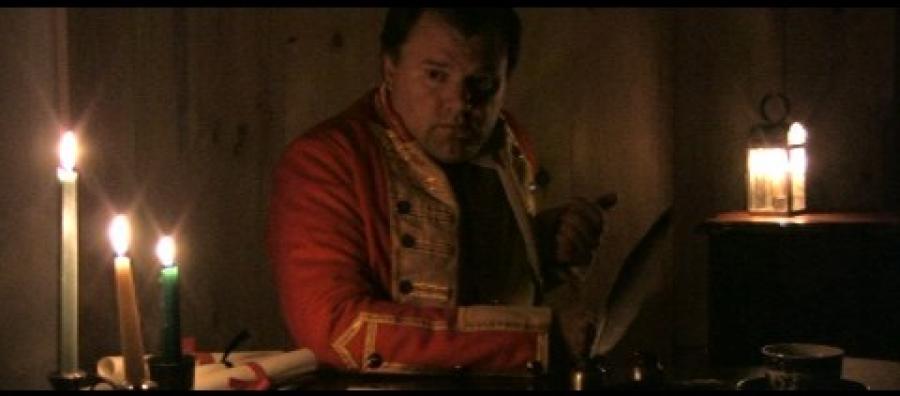Make a No Budget Movie: Chapter Five
I had a screenplay, but was content to let it sit for a while. My plan was to wait weeks or months, then do a second draft. The passage of time, I reasoned, would provide a fresh perspective. In the meantime, I would begin contacting more re-enactors and set a date to begin shooting. By now it was the last week of July, 2009, and I thought I could actually begin making the film by the spring of 2010.
This was probably a wise plan, and part of me thinks I should have stuck with it. I should have written another draft of my script. I should have recruited more actors, then sat around and done a few read-throughs to hash out the rough parts. But it didn’t turn out that way. I couldn’t stop thinking about my first draft, couldn’t stop thinking about how to shoot action scenes. I started to get excited, and I grew impatient. At last, I saw an opportunity and grabbed it.
I’d bought about twenty pine planks to build a new book case in my rec room. They were leaning against the wall next to the furnace room, waiting until I got around to actually putting them together. I was pacing back and forth one evening, thinking about sets and props, and my eyes fell on the planks. They reminded me of the wooden interior walls of the Fort Edward blockhouse, an historic site where one scene was set.
A thought struck me. I could build a mini set right now, right there in the rec room, using my pine planks as a backdrop. The scene was one in which Captain Noble meets with his commanding officer, Major Aldridge, and receives his orders to go after Renard. It was supposed to take place in Aldridge’s office, in Fort Edward, and I’d hoped to shoot it in the real blockhouse. But a set would do. I could always get a few shots of the blockhouse exterior later.
My mind made up, I got a roll of duct tape. Clearing a space in a corner of the rec room, I taped the planks to the wall, side by side. I then placed an antique pine table in front of them for a desk, with a wooden chair that looked more or less 18th century. Then I combed the house for other props that you might find on a British Army officer’s desk in the 1750s. I set up three candles and a small lantern. A gull feather I’d found in the yard served as a quill pen. Small rolls of paper tied with coloured ribbon could pass as documents and orders waiting for delivery. I even added a blue china tea cup and saucer, which was a nice touch, even though it wasn’t quite the right shape for the period. The one thing I didn’t have was a pair of ink bottles. I decided to make them from two small pewter candle holders topped by thick brass rings (the kind used in nautical rigging). The result looked fine, even though they wouldn’t hold ink.

With my camera in place on its tripod, I lit the candles and shot a few seconds of tape. I’d long been hoping that I could shoot a few interior scenes by candlelight alone, and though the shot was a little grainy, it looked good. Good enough, I decided, to keep going. I had some 18th century clothing with me, including a British officer’s coat, and reasoned that I could shoot the entire scene, playing the parts of both Noble and Aldridge. If it looked all right, I would then reshoot the scenes with my actors.
Taping the scene took about an hour, and when I was done I immediately uploaded the video to my PC and started editing. It was a pretty basic scene, alternating cuts of the two characters, Aldridge and Noble, as they faced each other across the desk. This was not how I had envisioned it originally – it was too static, the shots too tight – but it still seemed to work.
By two in the morning I was done. I burned the scene to a blank DVD, intending to take it to work the next day to show Rob Welch and anyone else who would watch. I was happy with it, happy with the warm look of the wood by candlelight, the dark shadows and the cluttered desk. I was even happy with my own acting and the pace of the scene, which was somber and a little menacing. For added drama, I’d given it a temporary score, a reflective violin piece from Mark O’Connor’s “Strings and Threads” suite. It suited the mood, though I would never be able to use it in the finished film.
I went to bed buzzing from post-excitement and exhaustion. At this point I hadn’t fully committed to shooting my movie for real, but I wanted to. I felt that if I didn’t just do it, I would think about it forever and it would never actually happen. The dream would fade and I’d move on to the next thing. But once I started, and once I started to see decent results, I’d be compelled to keep going, and the project would gain a momentum of its own. It didn’t matter if it wasn’t perfect, and didn’t matter if it didn’t exactly fit my original vision. There was no way it could be perfect.
It was more important that it actually happen.
Next: Location Shoot No. 1
